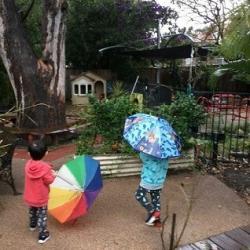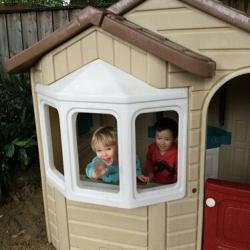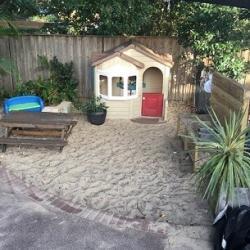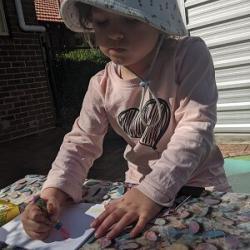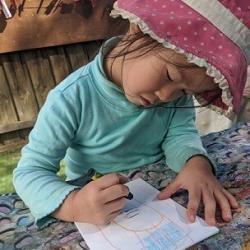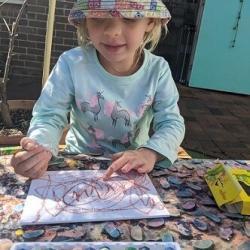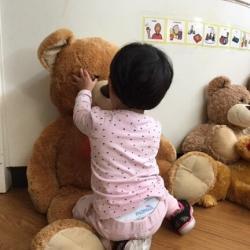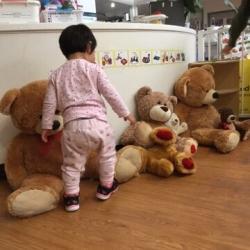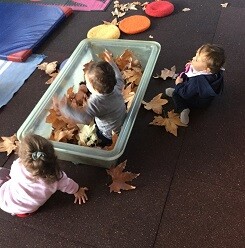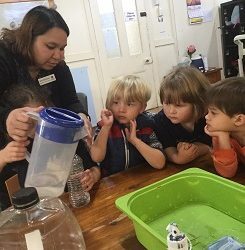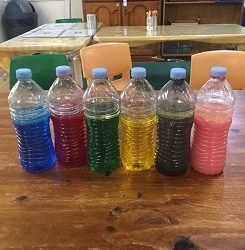Gorton House
While The Infants’ Home has remained in business as usual mode (a few social distancing-related adaptations aside), the Gorton House toddlers are slowly and surely returning to the fold. As our numbers increase and friendships are re-established, dynamics are put back into place and interests—both old and new—emerge, we find ourselves focusing on ensuring that the emotional needs of the children are met and that they feel welcomed, secure and safe while navigating the change to their routines.
One thing that has been introduced recently, and which is proving to be a great tool in helping the children transition, is a cubby house that has been set up in the sandpit. Our sandpit has been the focus of an aesthetic evolution for a little while now, and this new cubby house grabs the children’s attention and gives them a focal point from which they can explore.
We have been trying to re-establish the sandpit so that it is a) more aesthetically pleasing and b) more conducive to interest-based socio-dramatic play that will lead to further scaffolding and new learning opportunities. Part of that planning now involves the cubby house, which was very generously donated to us by Billie and Jack B’s parents (massive props guys, thank you greatly).
This cubby now forms the basis of the sandpit. It is the focal point to which the children gravitate, and it forms the foundation of most of the play that is taking place in the sandpit. The cubby, coupled with the outdoor kitchen and some permanent weather-proof resources, provides the children with an endless array of opportunities, limited only by their imaginations and personal experiences.
From the outset the cubby was an enormous source of interest, so much so that we had to break out the umbrellas and gauge its status first hand, regardless of the rain falling at the time—challenging the weather is nothing new for our toddlers, they thrive on it! Mel had spoken to the children during the morning and they were prepared to wait for the cubby house to arrive. Some were keener than others… Jack was prepared for its arrival the moment Mel told him it was coming. To say he was eager was somewhat of an understatement. So, armed with anti-rain equipment, the children set out to discuss the dos and don’ts attached to the cubby.
So far the play we’ve seen, and the way the sandpit is slowly being changed, has been really great. The cubby house is providing a focal point that is creating opportunities for extended focus times and other interests to be incorporated into play. Sam H has somehow managed to drag his current interest in sharks into the cubby and no one seems to mind a bit, his peer circle is actually embracing this somewhat left of field hybrid interest.
Now we have a set plan in mind and we have an aesthetic mapped out, it’s hoped that the final product will remain a permanent fixture that can embrace all four seasons. The children having an interest from the outset and being so avidly involved in its initial stages has created a vibe where they already have a sense of ownership towards it. It’s affectionately called “the cubby” by each and every one of them. Oh, and we’re still very much aware of the current social state that we find ourselves in, and as such have limited access to the cubby to only three children at any given time. This is not just for safety in these times—it also makes sense to limit possibilities for potential conflict and differences of opinion.
Johnson House
The children in Johnson House have been exploring art using a range of mediums. We have been talking a lot about colour mixing, as well as the idea of art being about the creative process rather than being focussed on the end product. These conversations have helped encourage children’s confidence with the idea of not being ‘wrong’ or ‘right’, and led them to being more open to experimenting and exploring new mediums they haven’t used before. Using watercolours, crayons and paints has provided the means for the children to compare and contrast mediums, problem-solve, as well as engage in conversations about the new or existing knowledge they have gained through such experiences.
Murray House
Infants
This week a load of teddy bears were donated to Murray House infants and this has helped to create such an inviting play space. We created a special ‘teddy bear corner’ and the children are fascinated with the new addition in their environment. They have been observed visiting the corner to find comfort, relax their bodies and enjoy moments of solitude by just simply leaning on the teddies. The children have also been giving the teddy bears lots of cuddles and pretending to put them to sleep while singing ‘Rock-a-bye Your Bear‘, one of their favourite songs by the Wiggles. This space has also been used as a resource to extend children’s learning about exploring feelings.
The educators in Murray House are grateful to have supportive families and members of the community who donate resources to assist us in providing meaningful learning experiences for the children.
Toddlers
This week we would like to extend a big welcome back to some of our children and families who have been away for a few weeks due to the COVID-19 pandemic. The children have displayed a strong sense of belonging to our Murray House community, as well as strong connections with their educators and peers, through their seamless transition back.
Connections with children are continuing to be strengthened and fostered through many intentional small group story times and social game experiences throughout the day. Story books and social games allow educators to share quality time, interactions, and experiences with children while also fostering the development of children’s early literacy and social skills, as well as their concentration.
The health and wellbeing of children, families and educators remains our top priority. Children’s play spaces and toys are regularly cleaned and disinfected. Life-long healthy food choices are embedded in our program and are regularly discussed with the children at mealtimes. Good hygiene practices like washing hands thoroughly before eating, after using a tissue, or after toileting is also modelled and demonstrated for the children intentionally throughout the day.
Rigby House
We are fortunate to be surrounded by beautiful grounds, trees and birds at The Infants’ Home. Rigby House has a beautiful Liquidambar tree nearby, and we enjoy watching the changes that occur to its leaves during different seasons. Even our youngest children are aware of the falling leaves; they point to the tree, and they enjoy picking up the leaves that blow into our grounds.
This week our educators supported the children’s interest in this tree and the seasonal changes that are occurring by providing an experience in which a large container full of leaves was offered for the children to investigate. It was lovely to see them approach the experience and to explore the leaves. Soon all of the children were climbing in and out of the container, enjoying the sound of the crunching leaves, and the feeling of the dry leaves as they held, squashed, pulled and threw them up high. The children’s enjoyment of the experience was evident as they laughed and squealed with delight!
Robinson House
The children and educators at Robinson House have been incorporating a lot of STEM (Science, Technology, Engineering and Mathematics) experiences into the educational curriculum. This learning has emerged from the children’s interests in mixing colours, connecting mathematical concepts such as measurement, following step-by-step procedures and making predictions, as well creating props for their ‘Mindfulness and Chill Out Space’.
This week the children have created sensory bottles by adding oil, water and food colouring to recycled bottles. Each bottle represents a ‘feeling’, based on its colour. For example, red represents ‘angry’ and blue represents ‘sad’. These bottles will bring a sense of calmness to the space, and the children will be able to use them to help themselves to self-regulate.
Meanwhile, discussions about food choices and healthy eating lead the children to conduct experiments using eggs, Mentos (a mint candy) and Coca-cola (Coke). The children watched with anticipation and curiosity as the shell of an egg that was placed in Coke dissolved. This represented our teeth. When a Mentos candy was placed in Coke, the acid from the soft drink reacted with the mint candy, pushing it out and making acid and gas, similar to what happens to our tummy when we don’t eat the right foods.
These intentional learning opportunities encourage the children’s curiosity and promote critical, inquiry-based learning, as well as providing a fun and creative curriculum for children.
